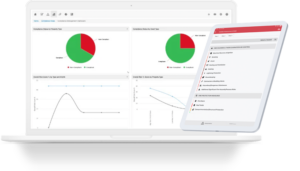11 Feb

In today’s fast-paced, data-driven world, digital transformation is reshaping industries across the board, and risk management is no exception. Traditionally, risk assessments were carried out manually using paper-based processes. These methods, though effective at the time, were often time-consuming, error-prone, and lacked the flexibility required in today’s rapidly changing environments. Today, digital platforms are revolutionizing the way businesses perform risk assessments, offering speed, accuracy, and automation in a way that paper-based methods simply cannot.
In this article, we’ll explore how digital transformation is making risk assessments more efficient, reliable, and actionable, and how businesses can leverage these new technologies to stay ahead of potential threats and challenges.
The Shift from Paper-Based Assessments to Digital Platforms
Risk assessments are a critical part of every business, helping organizations identify, evaluate, and manage potential risks that could affect operations, safety, or compliance. Traditionally, this process involved filling out forms on paper or in spreadsheets, reviewing documents manually, and then relying on internal teams to act on those findings. However, this system had several key limitations:
- Time-Consuming: Gathering and organising data manually could take hours or even days, leading to delays in decision-making.
- Prone to Errors: With paper or spreadsheet-based systems, mistakes could easily slip through the cracks, potentially compromising safety or compliance.
- Lack of Collaboration: Paper-based systems made it difficult for teams to collaborate in real-time, especially in large organizations or distributed teams.
The Benefits of using a Digital Platform for Risk Assessments
One of the biggest advantages of digital transformation in risk assessments is automation. By automating key processes, businesses can save time, reduce errors, and ensure that risks are accurately managed. Let’s dive into some of the specific benefits:
- Improved Accuracy and Reduced Human Error
Manual processes are inherently prone to human error, whether it’s inputting incorrect data, missing critical steps, or overlooking key details. In contrast, digital risk assessment platforms automate many of these tasks, ensuring that data is accurate, consistent, and free from human mistakes.
For instance, automated risk scoring algorithms can quickly assess and quantify risks based on pre-set parameters, eliminating subjective judgment and providing a more objective view of potential threats. This enhances decision-making and allows organizations to prioritize risks more effectively.
- Enhanced Collaboration Across Teams
Digital platforms allow assessors and decision-makers to collaborate in real-time, no matter where they are. With cloud-based systems, multiple stakeholders can access the same data, share insights, and track progress without the need for in-person meetings or lengthy email chains.
For example, when a risk assessment identifies a potential hazard, team members can be automatically alerted, and tasks can be assigned to the appropriate individuals. This streamlined communication ensures that everyone is on the same page and that critical actions are taken promptly.
- Remediation
When tasks are completed, they automatically reduce risk and ensure compliance. This feature provides you with real-time risk scores across your entire estate, shifting you from static risk snapshots to dynamic risk and compliance management.
Case Study: How Automation Transforms Risk Assessments in the Field
Consider the example of a construction company that has recently transitioned from paper-based risk assessments to a digital platform. Previously, assessors would need to manually fill out risk forms on site, often leading to delays when they had to return to the office to review and act on the findings.
Now, using a digital platform, the assessors can complete their risk assessments in real time using a mobile app. Data is automatically uploaded to a central system where it can be analysed and acted upon immediately. If any risks are identified, tasks are automatically created for relevant team members, ensuring that all action items are addressed on time. Not only has this process saved hours of manual work, but it has also improved the company’s ability to react to risks quickly, improving safety and efficiency across the board.
Conclusion
Digital transformation is a fundamental shift that is revolutionising the way businesses approach risk management. By moving from paper-based assessments to digital platforms, companies can streamline their risk assessment processes, improve accuracy, foster collaboration, and automate critical tasks. These advancements are not only saving businesses time and money but also helping them better manage risks and ensure operational safety.
As the technology behind these platforms continues to evolve, businesses that embrace digital transformation will be better positioned to stay ahead of potential risks and drive long-term success. In an increasingly complex world, making the switch to digital risk assessments is no longer just an option—it’s a necessity.
Recent Comments
Use Risk Warden to streamline, automate and visualise your processes to increase efficiency, lower costs, reduce risk, improve strategic performance, gain a competitive advantage and more.

Useful Links
© Copyright 2025 Risk Warden Limited

